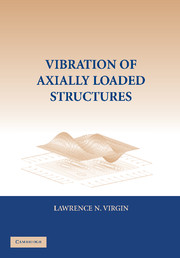Book contents
- Frontmatter
- Contents
- Foreword
- Preface
- 1 Context: The Point of Departure
- 2 Elements of Classical Mechanics
- 3 Dynamics in the Vicinity of Equilibrium
- 4 Higher-Order Systems
- 5 Discrete-Link Models
- 6 Strings, Cables, and Membranes
- 7 Continuous Struts
- 8 Other Column-Type Structures
- 9 Frames
- 10 Plates
- 11 Nondestructive Testing
- 12 Highly Deformed Structures
- 13 Suddenly Applied Loads
- 14 Harmonic Loading: Parametric Excitation
- 15 Harmonic Loading: Transverse Excitation
- 16 Nonlinear Vibration
- Index
- Plate section
8 - Other Column-Type Structures
Published online by Cambridge University Press: 05 May 2010
- Frontmatter
- Contents
- Foreword
- Preface
- 1 Context: The Point of Departure
- 2 Elements of Classical Mechanics
- 3 Dynamics in the Vicinity of Equilibrium
- 4 Higher-Order Systems
- 5 Discrete-Link Models
- 6 Strings, Cables, and Membranes
- 7 Continuous Struts
- 8 Other Column-Type Structures
- 9 Frames
- 10 Plates
- 11 Nondestructive Testing
- 12 Highly Deformed Structures
- 13 Suddenly Applied Loads
- 14 Harmonic Loading: Parametric Excitation
- 15 Harmonic Loading: Transverse Excitation
- 16 Nonlinear Vibration
- Index
- Plate section
Summary
The previous chapter focused attention on the behavior of axially loaded prismatic thin beams in which the external loading consisted primarily of loads applied at the end of the member or in which significant axial effects were induced (e.g., the membrane, or stretching, effect). In this chapter, the scope of the analysis is opened to include a wider variety of situations in which axial loading and dynamic effects are considered, but in which boundary conditions, for example, do not necessarily fall into simple categories. We will also typically have to rely more on approximate techniques. Furthermore, there are cases in which the geometry of the structure means that a system's vibration and stability characteristics may depend on a number of parameters not considered in the previous chapter that focused on relatively straightforward prismatic members. We start this chapter by looking at a couple of cases in which this happens.
A Beam on an Elastic Foundation
It is not uncommon for a beam to have some kind of continuous support along its length. We can think of this as an elastic foundation and assume the foundation stiffness is linear. A practical example of this might be the sleepers under a railroad track, where a significant axial-loading effect is caused by thermal expansion. Referring to the schematic shown in Fig. 8.1 and again assuming the ends of the beam are pinned, we can extend the analysis of the previous chapter.
- Type
- Chapter
- Information
- Vibration of Axially-Loaded Structures , pp. 147 - 165Publisher: Cambridge University PressPrint publication year: 2007



